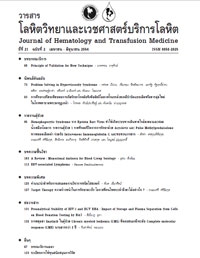การศึกษาเปรียบเทียบผลการเริ่มรักษาโรคมัลทิเพิลมัยอิโลมาครั้งแรกด้วยเคมีบำบัดแบบเดิมหรือยากลุ่มใหม่ ในโรงพยาบาลพระมงกุฎเกล้า
Keywords:
มัลทิเพิลมัยอิโลมา, ยากลุ่มใหม่, การเริ่มรักษาครั้งแรก, Myeloma, Novel agents, Upfront therapyAbstract
บทคัดย่อ
การรักษาผู้ป่วยมัลทิเพิลมัยอิโลมาที่เพิ่งได้รับการวินิจฉัยด้วยยากลุ่มใหม่มีอัตราการตอบสนองที่ดีขึ้น และมีอัตราการอยู่รอดโดยโรคสงบ (progression free survival) มากขึ้น แต่อัตราการอยู่รอดโดยรวม (overall survival) ไม่ได้ดีขึ้นในทุกการศึกษา เมื่อเปรียบเทียบกับการรักษาด้วยเคมีบำบัดแบบเดิม วัตถุประสงค์ : เพื่อเปรียบเทียบผลของการเริ่มรักษามัลอิโลมา ด้วยยากลุ่มใหม่กับเคมีบำบัดแบบเดิมในโรงพยาบาลพระมงกุฎเกล้า วิธีการ : เป็นการศึกษาย้อนหลัง ทบทวนผลการรักษาผู้ป่วยมัลทิเพิลมัยอิโลมารายใหม่ ที่ได้รับการรักษาด้วยเคมีบำบัดแบบเดิมหรือยากลุ่มใหม่ตั้งแต่ปี พ.ศ. 2540 ถึงปี 2553 ผลการวิจัย : มีผู้ป่วยในการวิจัยนี้ 61 รายได้รับเคมีบำบัดแบบเดิม 48 รายและยากลุ่มใหม่ 13 ราย โดยในกลุ่มหลังมีผู้ป่วยที่มีโรคในระยะที่สามมากกว่า (ร้อยละ 69.2 เทียบกับ 27.1; p = 0.008) ระยะเวลาการติดตามเฉลี่ย 34 เดือน (12 - 106 เดือน) อัตราการตอบสนองจากการรักษาด้วยเคมีบำบัดแบบเดิมและยากลุ่มใหม่อยู่ที่ร้อยละ 79.5 และ 84.6 ตามลำดับ (p = 1.000) แต่ยากลุ่มใหม่ได้การตอบสนองอย่างน้อย very good partial response (VGPR) มากกว่า (ร้อยละ 60.0 เปรียบเทียบกับ ร้อยละ 23.8, p = 0.038) โดยเคมีบำบัดแบบเดิม และยากลุ่มใหม่ มีอัตราการอยู่รอดโดยโรคสงบ เฉลี่ย 15 และ 12 เดือน (p = 0.304) และอัตราการอยู่รอดโดยรวม 41 และ 30 เดือน (p = 0.507) ตามลำดับ มีเพียงการได้การตอบสนองอย่างน้อย VGPR เท่านั้น ที่สัมพันธ์กับอัตราการอยู่รอดโดยโรคสงบดีขึ้น (p = 0.010) สรุป : ยากลุ่มใหม่ให้การตอบสนองอย่างน้อย VGPR ที่มากกว่า แต่เนื่องจากขนาดตัวอย่างน้อย ลักษณะประชากรที่ไม่สมดุลกันในทั้งสองกลุ่ม และ ผลของการรักษาในครั้งต่อไป (salvage therapy) รวมทั้งการปลูกถ่ายสเต็มเซลล์ การศึกษานี้ จึงไม่สามารถแสดงให้เห็นความแตกต่างในด้านอัตราการรอดชีวิตได้
Key Words : มัลทิเพิลมัยอิโลมา ; ยากลุ่มใหม่ ; การเริ่มรักษาครั้งแรก
Abstract
Novel therapy for newly diagnosed multiple myeloma (MM) provided better objective responses and longer progression-free survival (PFS), but not longer overall survival (OS), compared with conventional chemotherapy. Objectives : To compare the outcomes of conventional chemotherapy (CONVENT) and novel agents (NOVEL) as the first-line treatment for MM at Phramongkutklao hospital. Materials and Methods : We retrospectively compared outcomes of patients with newly diagnosed myeloma treated with either NOVEL or CONVENT from 1997 to 2010. Results : Sixty-one eligible patients were enrolled into the study. There were 48 and 13 in CONVENT and NOVEL groups, respectively. The NOVEL group had more stage III diseases than the CONVENT group (69.2% vs 27.1%; p = 0.008). The median follow-up was 34 months, range 12 - 106 months. Objective responses after CONVENT and NOVEL were 79.5% and 84.6%, respectively (p = 1.000). There were more patients achieving at least very good partial response (VGPR) in NOVEL than in CONVENT groups (60.0% vs 23.8%; p = 0.038). Median PFS and OS in CONVENT vs. NOVEL were 15 vs. 12 months (p = 0.304) and 41 vs. 30 months, respectively (p = 0.507). Only the response after a first-line treatment significantly related to PFS (p = 0.010). Conclusions: Novel agents yielded deeper responses when used as first line therapy. However, survival benefit could not be demonstrated probably due to the small sample size, imbalance in baseline characteristics and several subsequent treatments including stem cell transplantation.
Key Words : Myeloma ; Novel agents ; Upfront therapy


